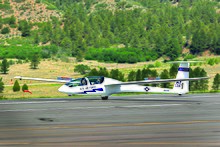| DG-1000 | |
|---|---|
 DG-1000 with 20 metre wingspan. DG-1000 with 20 metre wingspan. | |
| General information | |
| Type | Two-Seater Class sailplane |
| National origin | Germany |
| Manufacturer | DG Flugzeugbau |
| History | |
| First flight | July 2000 |
The DG Flugzeugbau DG-1000 is a two-seater class glider built by DG Flugzeugbau. It first flew in July 2000 at Speyer in Germany. There are four models, with 18- and 20-metre wings of HQK-51 profile. The latest DG-1001 variant replaced the DG-505 in production.
With 18 m (59 ft) span wings it is fully certified for aerobatics (+7 -5 g); with a 20 m (66 ft) span wings it is certified for limited aerobatics (+5 -2.65 g).
The engine (DG1000T) is mounted on a pylon aft of the double cockpit. There is a reduction gear (2.3:1.0) between the engine and the two-blade carbon-fibre composite propeller. The propeller was designed by and made in the DG factory.
Operational history
In 2011, the DG-1000 was selected by the USAF as a replacement for the Blanik TG-10. It will serve as a basic soaring trainer for cadets at the United States Air Force Academy. It also serves as the primary competition platform for the USAF Academy Aerobatic Demonstration Team. Its USAF designation is TG-16A.
Variants
- DG1000S
- Basic unpowered variant, two or three wheel configuration, with provisions for a retractable landing gear.
- DG1000T
- Retractable pylon-mounted engine, aft of the cockpit, with a 2.3:1 reduction gear driving a two-blade carbon-fibre composite propeller, designed and produced by DG.
- DG-1001
- Refined version with electric landing gear retraction.
- DG-1001e neo
- fitted with front electric sustainer – due to fly 2020.
- TG-16A
- USAF designation. Used to train cadets in soaring at the United States Air Force Academy, replacing the LET TG-10 Blanik.
- Akaflieg Karlsruhe AK-9 or
- A 0.400 kN (90 lbf) turbojet engine was installed in a two seater DG-1000. In Cooperation with the Institute for Thermal Flowengines at the KIT the behavior of the AMT Titan turbojet, from Dutch producer Draline, was researched, improved and fitted with an exhaust attenuator.
- DG-1000J:also known as 'Akaflieg Karlsruhe AK-9', registered D-KAKJ, named "Jet".
Operators
Military
 Australia
Australia

 United States
United States
Specifications (DG1000T)
Data from
General characteristics
- Crew: 2
- Capacity: 160 kg (353 lb) of water ballast
- Length: 8.57 m (28 ft 1 in)
- Wingspan: 18 m (59 ft 1 in) with 20m option available
- Height: 1.6 m (5 ft 3 in)
- Wing area: 17.5 m (188 sq ft)
- Aspect ratio: 22.8
- Airfoil: HQK-51, designed by DLR Braunschweig
- Empty weight: 461 kg (1,016 lb)
- Max takeoff weight: 750 kg (1,653 lb)
- Propellers: 2-bladed DG fixed-pitch propeller
Performance
- Maximum speed: 270 km/h (170 mph, 150 kn)
- Cruise speed: 111 km/h (69 mph, 60 kn)
- Stall speed: 68 km/h (42 mph, 37 kn) with 20m extension
- Never exceed speed: 270 km/h (170 mph, 150 kn)
- g limits: +7,-5
- Maximum glide ratio: 46.5
- Rate of climb: 1.3 m/s (260 ft/min) (engine on, still air)
- Rate of sink: 0.61 m/s (120 ft/min) (engine off and retracted)
- Wing loading: 32 kg/m (6.6 lb/sq ft) (with 80kg payload)
Sources
References
- ^ Barnard, Nick (2007). How to Fly a Plane. United Kingdom: Thames&Hudson. p. 51.
- Bayerl, Robby; Martin Berkemeier; et al: World Directory of Leisure Aviation 2011–12, page 142. WDLA UK, Lancaster UK, 2011. ISSN 1368-485X
- "AF Academy buys 19 new gliders for cadet training | koaa.com | Colorado Springs | Pueblo |". koaa.com. Archived from the original on 2012-03-24. Retrieved 2012-12-06.
- ^ Baillie, Amber (2012-07-26). "End of an era: 94th FTS phases out TG-10 gliders". Usafa.af.mil. Archived from the original on 2013-01-04. Retrieved 2012-12-06.
- DG-1000 Sailplane – A flight test evaluation
- Tacke, Willi; Marino Boric; et al: World Directory of Light Aviation 2015–16, page 174. Flying Pages Europe SARL, 2015. ISSN 1368-485X
- DG Flugzeugbau. "DG-1001e neo Project Update". Retrieved 8 July 2020.
- "DG Flugzeugbau: AAFC". Dg-flugzeugbau.de. Retrieved 2014-01-16.
- "L'Armée de l'Air et de l'Espace réceptionne son premier motoplaneur électrique". 15 March 2024.
- "DG Flugzeugbau: DG-1001 Club Indonesien". Dg-flugzeugbau.de. Retrieved 2013-06-05.
- "Factsheets : 94 Flying Training Squadron (AETC)". af.mil. Archived from the original on 3 March 2016. Retrieved 15 March 2016.
- Barnard, Nick (2007). How to Fly a Plane. United Kingdom: Thames&Hudson. p. 51.
- DG Flugzeugbau (2002). DG1000S Flight Manual. External PDF accessible here: https://ddsc.org.au/wp-content/uploads/2021/10/DG1000S-Flight-Manual.pdf
- DG-1000S/T specifications. https://web.archive.org/web/20071219093418/http://www.dg-flugzeugbau.de/Data/dg1000-einlegeblatt-e.pdf
External links
![]() Media related to Glaser-Dirks DG-1000 at Wikimedia Commons
Media related to Glaser-Dirks DG-1000 at Wikimedia Commons
| Glaser-Dirks and DG Flugzeugbau aircraft | |
|---|---|
| USAAC/USAAF/USAF glider aircraft designations 1924–1962, Tri-Service designations 1962–present | |||||||||||||
|---|---|---|---|---|---|---|---|---|---|---|---|---|---|
| USAAC/USAAF sequences (1924–1947) |
| ||||||||||||
| 1948 USAF redesignations | |||||||||||||
| Tri-Service sequence (1962–present) | |||||||||||||
| Not assigned | |||||||||||||